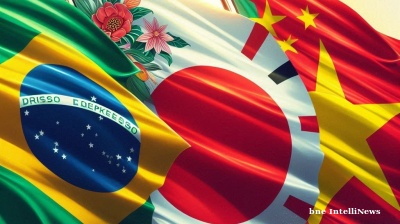Iran looking to complete North-South Corridor infrastructure rollouts ‘on Putin’s dime’, says analyst

Iran is looking to complete North-South Corridor infrastructure rollouts “on Putin’s dime”, according to Russian International Affairs Council analyst Nikita Smagin.
Russia sorely needs alternative transport routes for trade, having been cut off from its traditional Western ones following Moscow’s invasion of Ukraine. In terms of avoiding impacts of sanctions, the corridor through Iran reaching to the Persian Gulf and Sea of Oman (Indian Ocean) looks like the safest option, says Smagin, in an assessment for Carnegie Endowment.
Iran is, meanwhile, on the one hand unable to finance the completion of the corridor (sometimes referred to as the International North-South Transport Corridor, or INSTC, or just NSTC) and on the other hand well aware of the situation Russia now finds itself in and why it wants the route, notes Smagin, adding: “Iran’s goal, therefore, is to modernize its own infrastructure using Russian money.”
“Russia, for its part,” says Smagin, “seems resigned to footing the bill. In mid-May, Deputy Prime Minister Marat Khusnullin said that Russia would spend 250–280 billion rubles (about $3.5 billion) on the North–South Corridor by 2030. In all likelihood, that is a major underestimation. But Russia has no choice: it needs the North–South Corridor, and no one else is willing to invest in it.”
Proper functioning of the corridor will not be possible without investment in securing a 162-kilometre Rasht (Iran)–Astara (Azerbaijan) railway line, adds the analyst, pointing out that finance will also be required for a great number of other necessities, meaning “Russia will therefore need to invest over and over again: in roads, ports, depots, and additional infrastructure.”
Russian President Vladimir Putin called on Russian businesses in mid-March to invest in constructing the Rasht–Astara line. The interest does not appear to be there, however, and it was revealed in May that the Russian government will be funding the project itself, by issuing a €1.3bn loan to Iran.
Says Smagin: “The cooperation via loans is becoming the backbone of Russo-Iranian relations. In 2021, for example, Russia loaned Iran $5 billion for infrastructure projects. That same year, it emerged that Iran owed 500 million euros ($591.5 million) for the construction of the Bushehr nuclear power plant. Iran’s debts for Russian agricultural products are also rising by the month.
“Russia continues to provide loans despite Iran’s ballooning debt from previous projects. Given Tehran’s financial precarity and ongoing political crisis, it’s doubtful that those loans will ever be repaid.”
As things stand, if everything goes to plan the Rasht–Astara railway, a technologically demanding feat due to difficult terrain, will only become operational in 2027. What’s more, if by then Azerbaijan still has strained relations with Iran, it’s far from certain that Baku will facilitate the smooth operation of the corridor through its territory.
As Smagin points out, the North–South Corridor could even find itself competing with Baku’s own pet project, the Zangezur Corridor: a hypothetical transport route linking Azerbaijan (and possibly Russia) to the Mediterranean Sea via Armenia and Turkey, though the Azerbaijanis and Armenians are yet to strike an agreement that would allow the operation of the route and Iran is opposed to it, partly given what it would mean as regards its influence in the South Caucasus.
Smagin also observes that legitimate questions have been raised about whether Rasht–Astara will be cost-effective compared with Iranian road transport, with gasoline heavily subsidised in Iran and road infrastructure significantly better than rail.
Alternative transport routes for Russia go through China and Turkey, but with them would come uncertainty, adds Smagin, saying: “Despite Putin and Xi’s ‘no-limits partnership,’ the United States remains China’s largest economic partner, and China has proven unwilling to risk sanctions in the past. Türkiye is a NATO member and is even more closely economically integrated with the West. It has resisted many demands to crack down on Russian sanctions evasion so far, but may not remain a reliable partner for Russia for long. Heavily sanctioned Iran, on the other hand, has nothing to lose by working with Russia.”
Russia’s other options include expanding its Caspian cargo fleet in an effort at boosting trade with and via Iran by sea and reaching the Persian Gulf using railways in Kazakhstan and Turkmenistan, another neighbour of Iran. In May, Kazakh President Kassym-Jomart Tokayev proposed launching a high-speed freight line between the southern Russian city of Chelyabinsk and Iran, for which Kazakhstan would revamp its portion of the railway.
Opinion

ING: Trump’s Tariffs - Europe’s worst economic nightmare just came true
A US 20% reciprocal tariff on the European Union will hurt. It's worsened the eurozone's short-term outlook. Now, so much depends on European governments to push through with their planned fiscal stimulus and reforms to strengthen domestic economies.

BEYOND THE BOSPOROS: Regime panicky over opposition call for “No shopping day”
English rock band Muse, meanwhile, scrap Istanbul concert in solidarity with Imamoglu protesters.

COMMENT: Brazil’s Lula builds economic bridges across the Pacific
Brazil's President Lula boosted ties with Japan and Vietnam during his Asian tour last week, securing aircraft deals, beef markets and partnerships.

COMMENT: South Caucasus offers a potential diplomatic triumph for Trump
The new US administration wants to become the political team that ends the longstanding conflict between Armenia and Azerbaijan.


